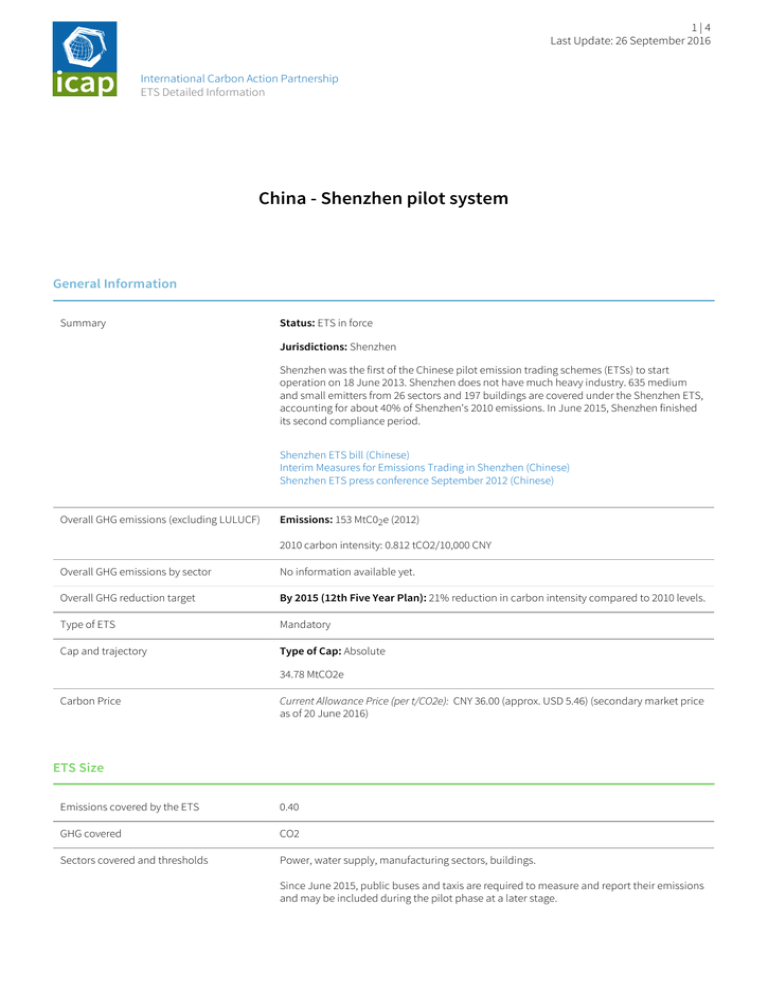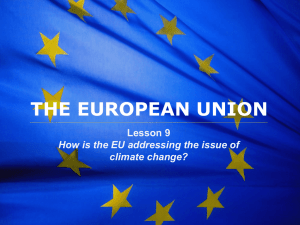
1|4
Last Update: 26 September 2016
International Carbon Action Partnership
ETS Detailed Information
China - Shenzhen pilot system
General Information
Summary
Status: ETS in force
Jurisdictions: Shenzhen
Shenzhen was the first of the Chinese pilot emission trading schemes (ETSs) to start
operation on 18 June 2013. Shenzhen does not have much heavy industry. 635 medium
and small emitters from 26 sectors and 197 buildings are covered under the Shenzhen ETS,
accounting for about 40% of Shenzhen's 2010 emissions. In June 2015, Shenzhen finished
its second compliance period.
Shenzhen ETS bill (Chinese)
Interim Measures for Emissions Trading in Shenzhen (Chinese)
Shenzhen ETS press conference September 2012 (Chinese)
Overall GHG emissions (excluding LULUCF)
Emissions: 153 MtC02e (2012)
2010 carbon intensity: 0.812 tCO2/10,000 CNY
Overall GHG emissions by sector
No information available yet.
Overall GHG reduction target
By 2015 (12th Five Year Plan): 21% reduction in carbon intensity compared to 2010 levels.
Type of ETS
Mandatory
Cap and trajectory
Type of Cap: Absolute
34.78 MtCO2e
Carbon Price
Current Allowance Price (per t/CO2e): CNY 36.00 (approx. USD 5.46) (secondary market price
as of 20 June 2016)
ETS Size
Emissions covered by the ETS
0.40
GHG covered
CO2
Sectors covered and thresholds
Power, water supply, manufacturing sectors, buildings.
Since June 2015, public buses and taxis are required to measure and report their emissions
and may be included during the pilot phase at a later stage.
International Carbon Action Partnership
ETS Detailed Information
2|4
Last Update: 26 September 2016
Inclusion thresholds: 3,000t CO2e/year for enterprises; 20,000m2 for public buildings and
10,000m2 for government buildings.
Number of liable entities
635 enterprises, 197 public buildings (2015)
The accounting boundary for emissions is set at the company-level (organizational and
operational boundary).
Point of regulation
Mixed: Both direct emissions from the power sector and indirect emissions from electricity
(and heat) consumption are included in the scheme. Electricity prices are regulated in
China, and therefore a scheme based on direct emissions alone would not induce a passthrough of carbon costs via the electricity price, and would not incentivize demand-side
management of electricity. The system therefore covers emissions from the power sector
upstream and other sectors downstream.
Phases & Allocation
Compliance period
One year (30 June)
Trading period
Three years (2013-2015)*
*Initially, the seven Chinese pilot ETS were scheduled to end after three compliance years
and be replaced by the national ETS in 2016. However, as the national ETS will not start
before 2017, the pilots will likely be extended until then.
Allocation
Allowances are largely distributed for free based on sector-specific carbon intensity
benchmarks for electricity, water supply and gas supply sectors.
In addition, a game theoretical approach that takes into account the companies' own
estimations of output and emissions is applied for manufacturing companies. Ex-post
adjustments are possible.
Up to 3% of allowances can be auctioned. As of January 2016, only one auction has taken
place (June 2014).
Flexibility
Banking and borrowing
Banking is allowed during the pilot phase. Borrowing not allowed.
Offsets and credits
Quantitative Limit: Domestic project-based carbon offset credits — China Certified
Emission Reduction (CCER) — are allowed. The use of CCER credits is limited to 10% of the
annual compliance obligation.
Qualitative Limit: Credits from hydro projects are not eligible and there are further
geographic restrictions for the use of certain CCERs.
Provisions for price management
In case of market fluctuations, the Shenzhen Development and Reform Commission (DRC)
can either sell extra allowances from a reserve at a fixed price. Such allowances can only
be used for compliance and cannot be traded. The DRC can also buy back up to 10% of the
total allocation..
Compliance
Monitoring, Reporting, Verification (MRV)
Reporting Frequency: Annual reporting of CO2 emissions with a tier approach taking into
account the size of the company.
Verification: Third-party verification is required.
International Carbon Action Partnership
ETS Detailed Information
Enforcement
3|4
Last Update: 26 September 2016
Penalties for failing to submit an emissions or verification report on time, providing
fake information or disturbing the market order can cost up to CNY 100,000 (EUR
13,088).Companies failing to surrender enough allowances to match their emissions
are fined three times the average market price of the past six months. The missing
allowances can be withdrawn from the account of the company or deducted from next
year's allocation.
Other Information
Institutions involved
Shenzhen Development and Reform Commission (Competent authority)
China Shenzhen Emissions Exchange (Trading platform)
Linkage with other schemes
No information available yet.
International Carbon Action Partnership
ETS Detailed Information
4|4
Last Update: 26 September 2016
Disclaimer
Copyright © 2012 by International Carbon Action Partnership (ICAP). All rights reserved. The content provided by the ICAP ETS map is
protected by copyright. You are authorized to view, download, print and distribute the copyrighted content from this website subject to
the following condition: Any reproduction, in full or in part, must credit the International Carbon Action Partnership (ICAP) must include a
copyright notice. If you have any questions please contact info@icapcarbonaction.com. Developed and designed by Lucid.Berlin
The initial data as of December 2012 was compiled by the ICAP Secretariat for ICAP jurisdictions and by Ecofys for non-ICAP jurisdictions.
Since then, the ICAP Secretariat has continuously updated the data for the ICAP and non-ICAP jurisdictions. Information compiled in the
ICAP ETS Map is based on official and public information, as much as possible, and focuses on cap-and-trade systems for greenhouse gas
emissions. The ETS map thus does not aspire to monitor all climate policy instruments. This website presents interim results of a continuous
working process. Although the information contained therein is assembled with utmost care, ICAP and Ecofys cannot be held liable for the
timeliness, correctness and completeness of the information provided.
Please refer to the imprint on the website of the International Carbon Action Partnership regarding links to external websites, liability and
privacy policy.


